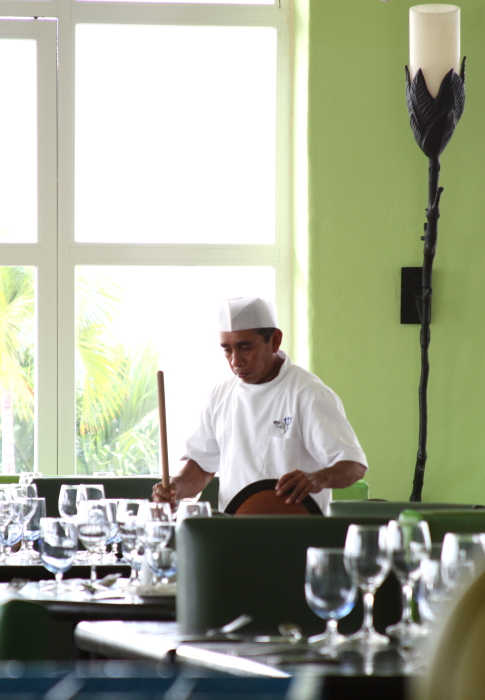 Bussing may be the most important aspect of service that is overlooked by restaurant owners and managers. Perhaps it’s because business owners think guests don’t pay attention to the little things like how a table is cleared or when a water glass is topped off. Maybe it’s a pervasive mentality that bussing is a simple job that anyone can figure out. But great bussing is a complicated job that requires experience, training, and passion for the work.
Bussing may be the most important aspect of service that is overlooked by restaurant owners and managers. Perhaps it’s because business owners think guests don’t pay attention to the little things like how a table is cleared or when a water glass is topped off. Maybe it’s a pervasive mentality that bussing is a simple job that anyone can figure out. But great bussing is a complicated job that requires experience, training, and passion for the work.
Go to an average restaurant and you may see some tell tale signs of a neglected bussing team. You may see an overflowing bus tub filled with dirty dishes hiding in a corner or see a busser cut in front of a guest on their way to clear a table at the end of their meal. You might watch as the rushed worker clinks plates together as they snatched up the dishes like playing cards. Maybe you’ll be left too long with an empty glass or a pile of empty sugar packets in front of you. You could find your table wet from a fast wipe down or a chair littered with crumbs. Perhaps you’ll cringe when your busser sticks their fingers in a stack of glasses as they carry them away. When a table goes neglected for long stretches and then is suddenly barraged by a fast moving busser struggling to clear the table at the end of the meal, diners feel rushed, ignored, or worse–unimportant or unseen. All of these things may seem minor at first, but when the problems add up during a meal, these little missteps begin to subtract quality points from your dining experience.
“How hard can it be to clear a table?” I’ve heard many a customer say in frustration. I’ve even seen restaurant owners and managers remark that “any idiot can bus a table” while failing to show the staff how to do their job better. But the truth of the matter is, clearing and re-setting tables in a timely fashion isn’t a simple thing. Bussing requires skill, training, timing, grace, hospitality, and efficiency.
Investment in Service
Because restaurants are in the business of earning profit through the pennies and nickles on every dollar, many restaurant owners choose to focus their support staff training in one area alone: clearing tables quickly. Typically, the instruction offered isn’t so much a formal training as it is daily tirades on the need to “move faster!”
The general lack of guidance and good coaching leads to all sorts of sloppy choices. Rather than challenge their staff to work smart, clean, and gracefully, the average restaurant leader pushes their support staff to cut corners, take shortcuts, and do whatever it takes to clear and reset a table in a timely way. Many business sacrifice the quality of their service over the long term in order to chase the short game of getting a single table cleared quickly. The result of this short term thinking: thousands of dollars of loss in breakage, lost silverware carelessly tossed in garbage pails, unhappy customers, and food that is mistakenly thrown away that has to be re-fired for a customer’s to-go request.
First Rate Bussing and Service Ninjas
What makes a first rate busser is a combination of skill, talent, and passion. Take the time to observe a great busser and you’ll notice something different about what they’re doing right away. The best bussers are elegant in their movements and effective in all that they do. They operate under the radar, move with purpose, and–like a ninja–are silent warriors who take pride in their work, regardless if you notice them. A great busser is a collaborator, a team player who lives for assists, and enjoys making other people look good at their job.
So how do you train someone to become a service ninja?
Proper training requires time and willing students. Thoughtful repetition, hands on guidance, and constant vigilance is what’s required to create and maintain a quality service staff. Training a bussing team is a monotonous effort that requires patience, time, and compassion–something many restaurant managers don’t have an abundance of. Training people how to clear a table may not be sexy work but diligence pays off in financially attractive ways. Restaurant owners who commit to teaching staff to improve their service on a daily basis are leaders in their field.
Some restaurant owners may know the importance of the giving the guest what they need, but don’t have the tools or ability to communicate the intricacies of how to give great service. Owners may instinctively know they need to map out the dining experience–down to the feel of the napkin, the length of the staff aprons, the temperature of the room, the vibe of the playlist, and even the angle of the silverware on the table–but they often lack the base line knowledge that result in outstanding service. While first time business owners quickly learn how to deal with construction headaches, zoning, and opening budgets, they often lose their energy when it comes time to training their staff before opening their doors.
That’s where someone like me comes in. Since I not only have a clear vision and passion for the finer points of service, I also have a passion for the artistry of the work. The people who hire me as a restaurant consultant know the importance of hospitality in its early financial success and trust me to bring them the tools they need to succeed. Like a midwife, I step in the final months before the official birthday of the restaurant to offer a helping hand in creating a uniquely tailored and elevated service program that will give first time diners a remarkable experience on their first day of business
A new restaurant that has a talented staff and strong service program creates dedicated customers who spread the word to their friends, write positive Yelp reviews, and lead to glowing press. A restaurant with a strong service team creates remarkable service worth talking about.

Bussing as an art form
As far as I’m concerned, bussing is craft that requires more attention and respect. A busser–or back waiter they are sometimes called–is a key member of a restaurant team. Just because a busser holds a support position responsible for cleaning of tables and the dining room, doesn’t mean what they do isn’t any less important to the service experience. As I’ve mentioned here before, waiting tables isn’t a job to be ashamed of or to be pitied. Waiting tables–just as bussing–is an honorable profession to be respected.
Job Description of a Great Busser
A great busser should be organized, work well with others, and keep priorities aligned with the teams’ greater goals. They should have pride in themselves, their work, and their uniform. Tables should be cleared in a timely manner, beverages should be filled when needed, empty dishes and cups cleared when appropriate, and pre-bussing of the table of unnecessary items is encouraged. Tables are cleared and re-set efficiently and gracefully. A support staff member enjoys going the extra mile for guests and for co-worker. A valued busser faces challenges with enthusiasm and a passion to do the job well. They know the menu and enjoy finding ways to make guests happy.
Tips on Being a Better Busser
Regardless of what a person’s position is, everyone on staff at a restaurant should know how to clear a table properly. Every restaurant will have its own style–be it fine dining, fast casual, diner, or casual fine dining–but restaurant owners should define how they want their service to feel before teaching their staff a method of clearing. Consistency is key in making sure table service is compatible across the dining experience.
1) Clear Thoughtfully
When guests appear to be done, approach the table and–if they are engaged in discussion–pause before clearing away dishes with food on them. The guest may want to continue eating. When complete, take plates off a table as quietly as possible. Removing dishes with the least amount of noise should always be the goal. Clinking of silverware and banging of dishes makes for a distracted dining experience for the guest.
Fine Dining: Stack on your arm, making sure you clear as many plates as you can carry without leaning the plates against your body. Options: never hand a dish over to someone else in the dining room, hugging the guest. Crumb the table, remove all crumbs from the table using a crumber or a sanitized cloth.
Casual: clear into hands or onto a tray, wipe down the table with a sanitized cloth.
Pet peeves: asking a question like “Are you done working on that?” makes eating sound like a chore. Using formal language like “May I clear your plates?” offers a simple request in language that’s more friendly and to the point.
2) Know When to Clear
Every restaurant has a different way of approaching clearing. Having a clear understanding of what each restaurant’s service culture is imperative. Not all restaurants approach clearing the same way.
Fine dining: clear only when everyone is done. Options: Clear ladies first, synchronized clearing (clear everything at once and at the same time), clear completely, Casual: Clear appetizers when each person is done. Clear entrees when when everyone is done or when each person is done. Wipe down the table
Super Casual: Take empty plates as they are done. Take empty plates when they have been untouched for a minute or more.
Pet peeves: clearing a table too early or too late. You never want to make a guest feel rushed or ignored. Finding a balance between the two requires some finesse and keen observational techniques.
3) Everyone is a Busser
No matter what level of service a restaurant offers, no one should be above clearing a table or assisting a guest with an issue that requires some cleaning up. Everyone should work as a team to assist guests in their bussing needs. All staff should always keep their eyes open and be observant of where everyone in the dining room is in their meal. Prioritizing the work and minimizing steps in the process are key aspects to clearing tables in a timely and graceful manner.
4) All Hands On Deck
Bussers, servers, runners and maangers are in the business to help guests. Everyone should keep their eyes open and their hands ready to assist. Teaching staff to have a “full hands in, full hands out” mentality on the floor will make everyone twice as effective since they will always be seeking to be of assistance no matter where the employee is in the restaurant.
My experience as a restaurant professional has shown me that business owners who fail to teach staff the intricacies of great busing suffer from lower sales, unhappy guests, and uneven service. Great bussing not only increases check averages and the number of guests served, it creates a happier culture and better work environment for all involved.



Oooooo I love the idea of a service ninja!! This post will help many business owners and people looking to be of service.
I agree with you on a lot of points. But being a lead busser is hell When you do 600 covers a night, every night. And it’s in a window of 4 hours. Kegs changed, 74lbs of booze up a flight of stairs, at least 7 times in the bar break, not to mention though out the night.
A Ninja Busser is an art and an honor. I am proud to be one of the few
You write the most meaningful posts. Thank you for giving me the opportunity to peer into the world of service and bussing.
Thanks Allison!
Interesting! Hope more restaurants make copies and include it in their training!!
i just ran into your blog and i’m catching up on your posts. Great work and thank you. I wanted to comment on this post since nothing leaves a better impression for me than bussers. When I see a happy busser that takes pride in his/her work, I know management is on top of its game and is focused on service, the customer, and his/her people. These are the restaurants I return to.
I’m quite glad to have found your website. I’ve been in high-end off-premise catering for more than a decade, and it’s remarkable how poorly the bussers are often treated. It is truly a service requiring finesse and a great deal of practice. I’ll certainly bring this up in a meeting with management next week.
I will certainly be looking out for further posts from you.
Thank you.
I have just recently been hired as a busser for the first time, this post is very helpful! I found that they were not so detail oriented on my first day of training, it was a bit wishy washy so I will have to brush up on these next time. Thank you!
Why do busspersons clear dirty dishes and then handle clean dishes as they set tables? Can’t germs be transferred? Cold sores, flu germs, etc. if hands are not washed between handling dirty dishes and clean dishes?
A great busser creates a top notch experience for the guests. It also transforms a waiter’s evening as well. The best waiters notice great bussers and reward them for it. A little extra tip out goes a long way.
See I’m not just a busser I’m a service ninja. I like that lol. But litterally at the resturaunt I work in I do all of these things but a great busser just isn’t recognized. No matter how much extra I put in, A corporation won’t bump my pay or increase tip outs. I make everyone else’s jobs easy as pie while I run around for 6 hours at a time without a break or a drink. Not because I have to, but it’s just in my blood I guess. I care, for no damn reason. But it gives me time to think. and I’ve figured out that bussing is a job for the people that care about others more than themselves. I could care less if I skip a meal but would be damned to let someone I care about starve. And would sacrifice my good name to strengthen yours. This is a great busser.. No recognition needed. Self satisfaction is a must.
I feel your pain. I’ve always cared about EVERYTHING I do. Kick ass at every job because of how much I care. However, not properly reciprocated financially and am treated like crap by servers. Management ignores team member complaints, so the bussing team, and fellow servers who are also treated like garbage, are left to suffer.
I miss working in an environment where the best was always expected and the pay reflected those expectations. I make about half of what servers make (only based on reported tips, of course… aka servers usually only reporting a base % of tips on sales- 14% where I work), do amazing at my job, and am still treated like crap.
Can’t wait to get out of the industry. Bad management leading to poor teams along with bad pay has scarred me. So done.
This is a fantastic break down on bussing, service and attitude for success. I’m taking “still working on that” out of my vocabulary.
Thank u very much I’m.bout to start my 1st busing job this will help.alot
I work as a busser in Miami making $8.50 an hour and about $45-$80 a day in tips. I am well respected my management and feel this post is very spot on.
Wish I was in the same situation. Only make $4/hour plus $50-75/hr in tipshare and get treated like crap by the same few jerks management never calls out. I do an amazing job, yet still get constantly bullied by the same staff members. Regional manager of course gets along with the two-faced bullies, so will likely never be resolved.
No wonder our turnover for bussers is so high… I’m the only one to stay more than a couple months. Waiting on my college degree later this year to escape the hell hole.
More money for less anxiety and less drama. Thank God.
I am in a stranger spot as well I make $2.50/hr with about $35-$45 tips per shift but I am loved by all the workers there, even the owners whom I personally know. Figures
I am just reading this for the first time. How incredibly thoughtful! I am a fast-casual restaurant manager in Texas and have had several negative comments concerning our noisy, clinking bus carts and the sounds of forks scraping against plates echoing throughout our dining room. How do you suggest I could train my staff to enhance my guests’ experiences in this way? How does one “bus quietly”?